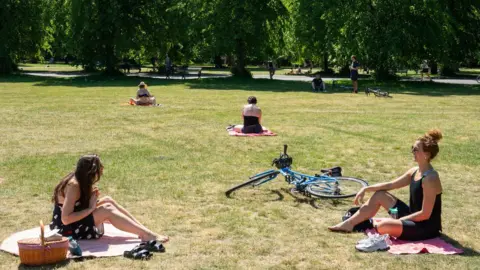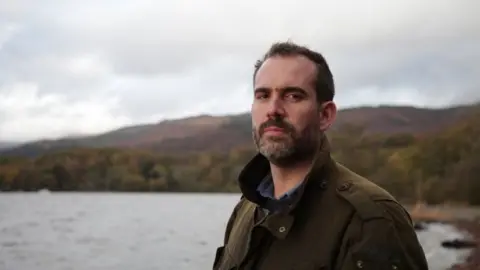Social distancing: A practical guide to how to socialise now
 PA Media
PA MediaThe UK is starting to relax its coronavirus lockdown rules, meaning some of us can now see friends and family we have been separated from for months.
Under the new rules:
- From Monday, people in England can meet in groups of up to six people in outdoor spaces like parks or private gardens - as long as you remain two metres (six feet) apart
- In Scotland, members of two different households - up to eight people - are allowed to meet outdoors if they maintain social distancing
- In Wales, people from two different households will be able to meet each other outdoors from Monday while maintaining social distancing
- Groups of up to six people who are not in the same household can meet outdoors in Northern Ireland if they stay two metres apart
We asked doctor and TV presenter Xand van Tulleken for his thoughts on ensuring our gatherings are as safe as possible.
Details of the rules vary across the UK, so if you are living outside of England some of the advice below may not apply to you.

1. Who to invite
The first thing to do is think about who you're inviting and what pressures that invitation will put on them - we are very differently vulnerable to this virus.
If you're inviting overweight men who are older, they face a very different risk to young families with young children. If you're inviting people who've had the virus that's very different again. Think about the invitation and think about who you're putting at risk.
If you're thinking of inviting a 70-year-old overweight man, I would consider having quite a detailed conversation about the risks they were prepared to accept.
If you're shielding you obviously cannot attend these gatherings.
2. How to arrive
If you are hosting an event and people can get into the garden directly, brilliant.
If they can't and people are walking through the house, it would be reasonable to tell them to wear a mask, wash their hands when they get into the house, and then go straight into the garden. They shouldn't touch anything. You need to get them to the garden as quickly as possible.
3. Social distancing
To maintain social distancing, about a quarter of a tennis court is what you need for a six-person gathering if everyone is from different households, which is massive.
If you had 12 two-metre by two-metre picnic blankets, you would each need to sit at the intersections where the blankets meet to guarantee that you're two metres away from the other people in your group and two metres away from passersby. I don't expect everyone's got 12 picnic blankets but that is at least the distances that we're talking about.
 Getty Images
Getty ImagesYou need to find some way of measuring. You could get a two-metre pole, a bamboo cane, a tape measure or a broom or whatever you can improvise with, hold it and spin around in a circle - everyone needs to be able to do that without knocking into each other.
In your garden, you could mark two metres out with blankets, chalk or masking tape to create little zones for people - no-one from separate households should be sitting next to one another on a bench.
When we talk about gardens, I look at mine and it's a very small space. To have more than two people in it socially distanced would be impossible.
4. Food and cutlery
In terms of bringing your own cutlery, it's difficult. Everyone through these sets of guidelines is going to have to determine how much risk they're prepared to accept.
If you think you've had coronavirus and/or you're low risk, meaning you're young, you're slim, you're female - those are the main variables - your behaviour at a picnic is probably going to be much more relaxed with regards to things like sharing the potato salad and using other people's cutlery. But of course you need to be doing everything you can to stop yourself being a carrier and making other people ill.
If you are a man who's older and overweight and don't think you've had the virus, I would say bring your own cutlery and bring your own coleslaw.
5. Washing hands
If you're in the park you might not be able to wash your hands, so I would say bring hand gel, wipes and perhaps water to wash your hands with or identify a sink nearby.
If you're having people in your garden, you need to do everything you can to signal to them that things are not back to normal and to help them feel safe and you feel safe.
You could ask your guests to set their alarms for every 45 minutes or every hour in a staggered way, then everyone could wash their hands when their alarm goes off. If you're hosting, say to everyone "we're all going to wash our hands once an hour".
You could also have a sign somewhere in the toilet that says "wash your hands".
6. Using the toilet
There needs to be at least two minutes between people using the toilet.
You should flush with the seat down - a lot of people don't bother with this but the spray from the toilet generates an aerosol and there is coronavirus in bodily fluids.
Once you flush, then you need to wipe down the loo. You need either disinfectant wipes in the loo, or you need a spray with some disposable towels.
You also need a fresh hand towel for everyone drying their hands so you're not re-contaminating from the usual hand towel that hangs in the bathroom.
You want a pile of disposable towels and you want a large quantity of soap available in the bathroom. All the surfaces need to be wiped down.
Even then, remember it's not a risk-free zone. Probably the toilet paper is going to be contaminated - you are definitely taking a risk by doing this.
7. Reunions with children
You're not allowed to hug people and that's the rule. But in my experience, if a small child wants a hug, it's virtually impossible to stop them. For people with nieces, nephews, grandchildren, godchildren or other important children in their lives who they haven't been able to see for a long time, if you're going to a picnic in their garden, it's going to be quite difficult to avoid contact.
I would say, if you do end up having a hug at least don't grab the person and pull them into your face. A proper full-frontal hug is the most dangerous, but a child hugging your leg is much less dangerous.
The only safe advice though is not to hug.
8. Alcohol and time-limits
You should do anything you can do to signal that this is not a normal gathering. You are having a picnic or gathering at a time of a deadly serious disease circulating widely in the population. We still have a high level of transmission in the UK.
Alcohol does break down inhibitions and people get much more tactile when they're drunk.


The other thing is the time limit. If you spend all afternoon in the garden with people drinking, that's wildly different to coming over and saying we're going to sit two metres apart for an hour and we'll wear a mask on the way in.
Anything you can do to flag to people that this is not a normal gathering will make you and them feel safer.
9. The clean-up
The virus either moves through the air, or it moves through droplets coming out of people's mouths and landing on surfaces and people touching those droplets. I would get out your household cleaning products and wipe down all surfaces once people have left.
This virus is unpredictable and dangerous - significantly more dangerous than other viruses that circulate in the UK. We have to have quite a high level of paranoia about it.
